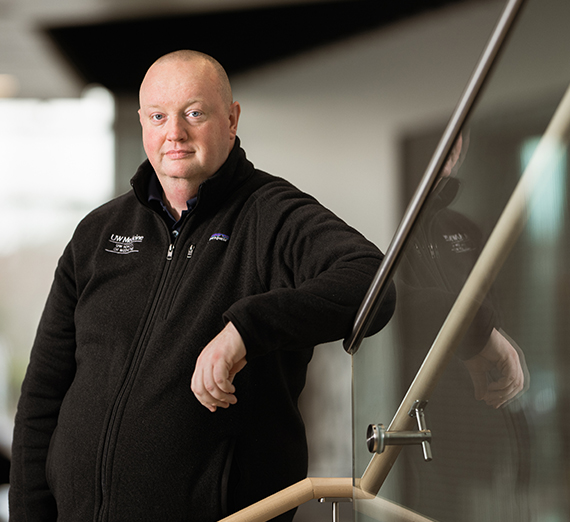UW-GU Highlight: Kevin Measor, Ph.D.

Several faculty members teach at both Gonzaga and the University of Washington School of Medicine. Here's a Q&A with one of them.
What do you enjoy teaching most at Gonzaga and why?
I enjoy teaching cellular neurophysiology. I find that students feel pretty lost at first and do not think they are learning “cool” neuroscience because they are learning about cells rather than some interesting behavior. However, by the end of the course, almost all the students have had that “aha” moment and realize that by learning about the nervous system at a cellular level, they really understand more about how things work at an organismal level. Learning about neurons allowed them to understand more about what it means to be human.
What do you primarily teach at the UWSOM and what do you enjoy most about it?
At UWSOM I teach a mixture of cellular neurophysiology, research methods, and neuroanatomy. I enjoy helping the students understand how what they are learning in the basic sciences applies to their clinical understanding of disease and wellness. I have had the pleasure of teaching several of my former GU students at UWSOM here in Spokane, some of whom I have known since they took their very first GU class with me. It is in those relationships I have really witnessed how they started this journey in the biological sciences to realizing the potential of all that knowledge as they are about to embark on their clinical rotations.
Where do you see potential for collaboration among GU and UW students? Do you have examples of seeing this in action?
I see the biggest potential for collaboration in sharing their knowledge and being role models for each other but also with the local community. For the past several years both the GU undergrads and the UWSOM medical students have been volunteering at local Spokane elementary school STEM fairs to help educate young kids about the brain, but more importantly being positive role models for these young students. At least once per year one of the GU or UWSOM students ends up volunteering at an elementary school that they actually attended and it is so rewarding hearing them share their story of success with the children. I have also witnessed the UWSOM students meet and then go on to mentor the GU students that they volunteer with, many of whom are pre-med.
How might you benefit personally or professionally through affiliation with both GU and UW?
Professionally, I am constantly sharing what I have learned in the curriculum at UWSOM with my GU students. Over the last five years, students who are Neuroscience, Biology, and Human Physiology majors at GU have been able learn about human neuroanatomy and its clinical correlates in the spring because that is what I am teaching the UWSOM students in the fall. We have been able to expose GU students to human specimens in the UWSOM anatomy lab, something that most undergrads at other institutions never have the chance to do. This opportunity has led us to offer a semester long Neuroanatomy course for the Neuroscience and Human Physiology majors for the first time this spring. I can tell you that the GU students are just excited as the elementary school children when they get to first hold a human brain, although that excitement wanes when they have to take their first pin test. For many of the sessions in the anatomy lab some of my UWSOM students and colleagues have come to assist my undergraduate students. I think my work at UWSOM also gives me “street cred”: My GU students trust me when I say that I have seen what it takes to be successful in medical school and that I believe that they are capable of achieving that level of success. Personally, I feel inspired each day because I get to work with students from age 18 all the way up to 40, and I get to watch my students work hard to achieve their goals and then to actually succeed in starting their dream career. It never gets old seeing both my former GU and UWSOM students on my social media getting a job, going to grad school, matching in a residency, getting married, or starting their families. They all go onto become such amazing people.
How do you see the partnership providing value to students and/or to the community?
In this time when higher education seems to be under attack from many sides and there is so much competition for enrollments and funding, it is amazing to witness two universities, seemingly as different as can be, come together for one mission. The partnership serves as a model not just for higher education but all public institutions, to utilize resources through collaboration rather than competition. Our GU STEM, Public Health, and Nursing students have befitted from the exposure to UWSOM clinical faculty and students, while the UWSOM students have benefited from exposure to GU faculty in learning things like leadership and social justice.
If you could help “fix” one thing in American health care, what might that be, and why?
Ha, this is a little out of my wheelhouse because although I work at a medical school, I am not that kind of doctor. I think there is lots of low hanging fruit here, like more access to health care or more affordable health care, but what I want to “fix” is more for my students. I wish that they had more time to be doctors, more time to get to know their patients, and more time to be the empathetic and compassionate individuals that I have gotten to know. I am not sure if that would “fix” health care but it sure would make health care feel less lonely knowing that your physician was a trusted partner in your journey.
Husky or Bulldog?
Who cares, both are just different breeds of the same dog.
